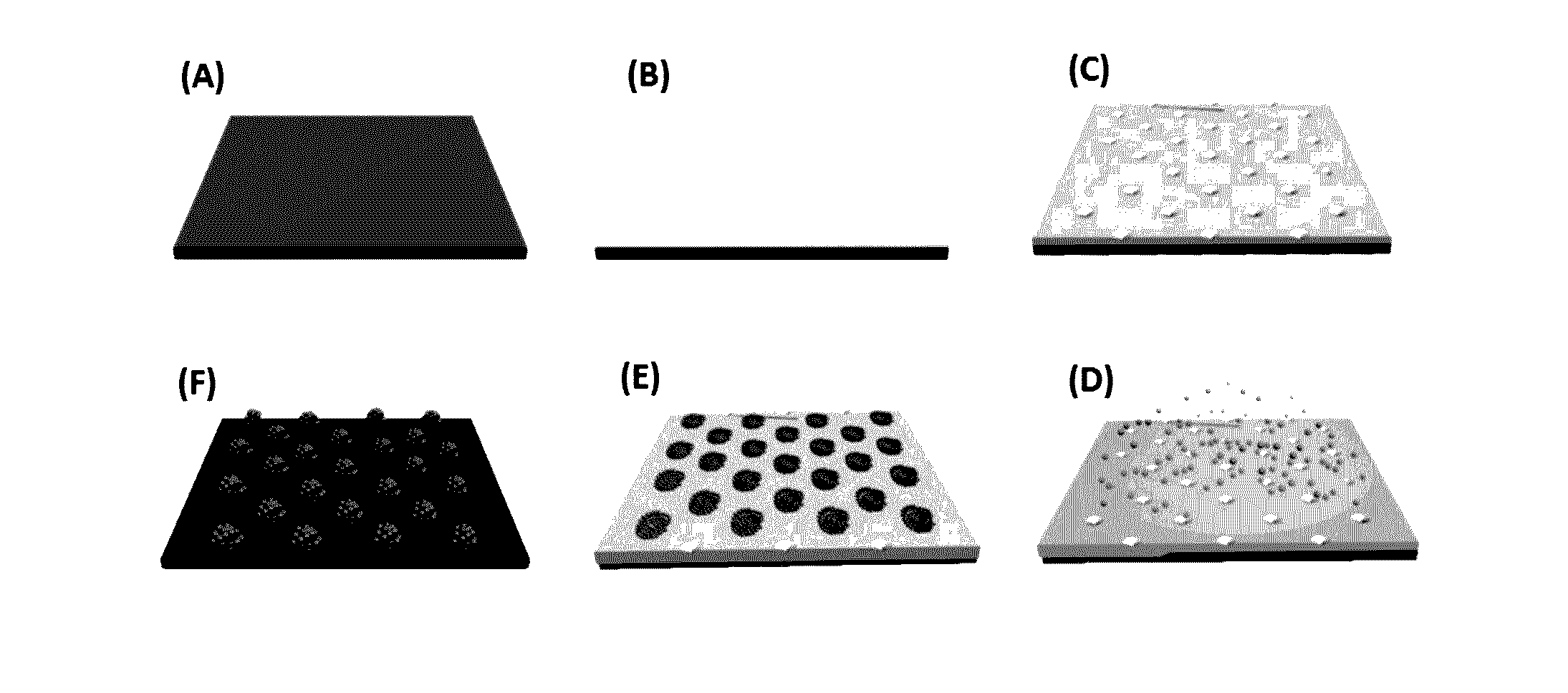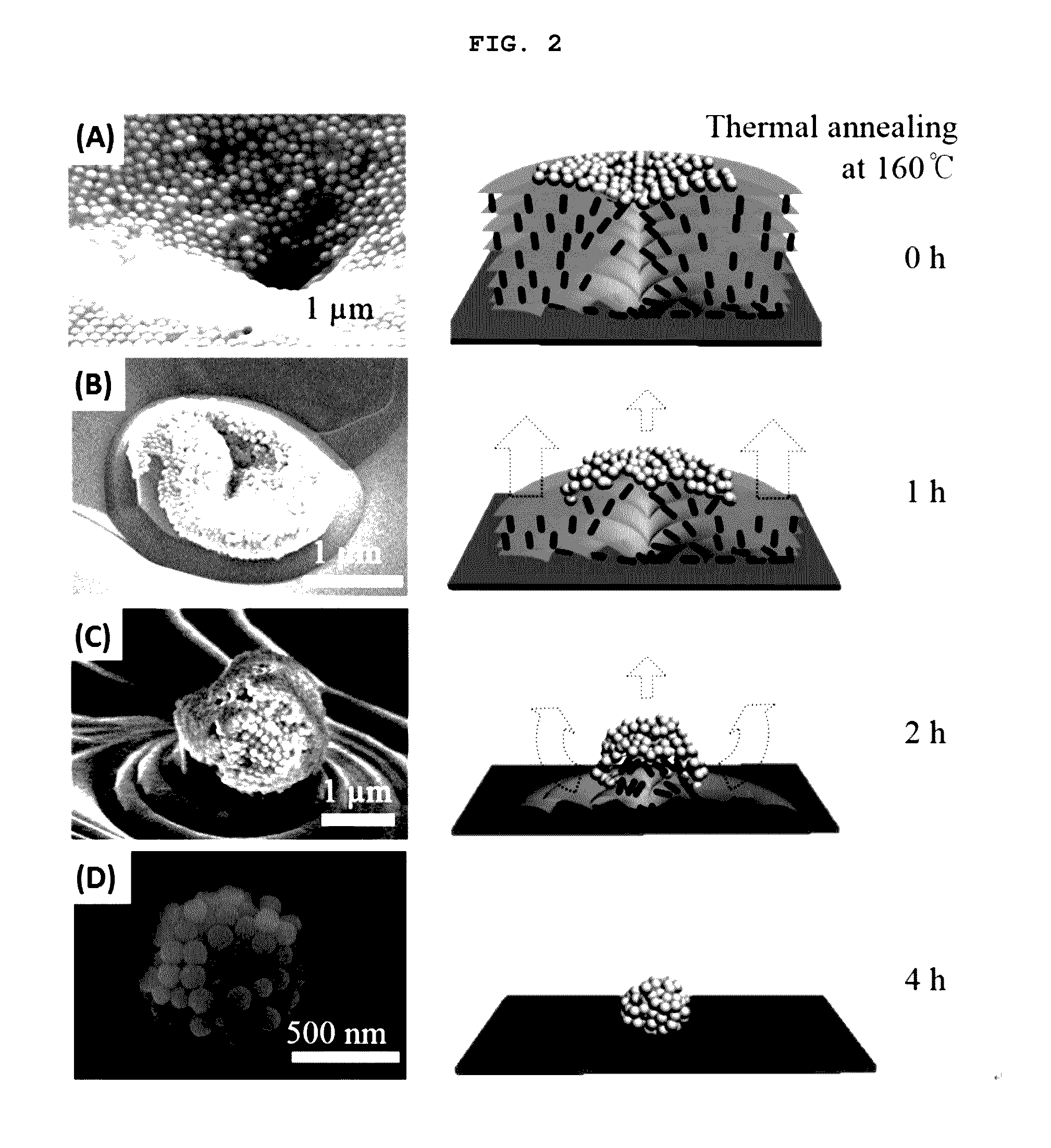Method of fabricating array of nanoparticle clusters using thermal transformation of sublimable liquid crystal film
a technology of sublimable liquid crystal film and nanoparticle clusters, which is applied in the direction of pretreatment surfaces, coatings, and silica, can solve the problems of complex process and expensive equipmen
- Summary
- Abstract
- Description
- Claims
- Application Information
AI Technical Summary
Benefits of technology
Problems solved by technology
Method used
Image
Examples
example 1
Synthesis of Liquid Crystal Molecules and Nanoparticles
[0039]As a main materials, fluorinated rod-type liquid crystal supermolecules, F—SiO2 nanoparticles, and multishell quantum dots (CdSe / CdS / ZnS) were prepared based on the synthesis method reported in “K. Kim, J. Y. Woo, S. Jeong and C. S. Han, Adv. Mater., 2011, 23, 911”.
[0040]Formation of Liquid Crystal Film on Substrate
[0041]A cleaned silicon substrate was exposed to oxygen plasma (100 W; running time: 2 min) to provide a substrate environment rich in active electrons. Then, the substrate surface was chemically modified with a glycol functional group using polyethyleneimine (Mw 60,000; Aldrich) by a spin coating technique (4500 rpm, 45 sec). This process provides an environment capable of horizontally orienting molecules to be clustered on the substrate (that is, capable of inducing high interactions with the conjugated electrons of the molecules), thereby determining the orientation of the molecules anchored on the substrate....
example 2
Formation of Spherical Clusters of F—SiO2 Nanoparticles on Flexible Substrate
[0048]An array of nanoparticle clusters was formed in the same manner as described in Example 1, except that a PDMS was used instead of the silicon substrate. The array was observed with an electron microscope, and the results of the observation are shown in FIG. 6.
[0049]As shown in FIG. 6, an array of nanoparticle clusters could also be formed on a highly flexible polydimethylsiloxane (PDMS) substrate.
example 3
Formation of Spherical Clusters of Quantum Dot Nanoparticles
[0050]A hexagonal array of spherical clusters was formed over a large area in the same manner as described in Example 1, except that 7 mg / ml of a quantum-dot (CdSe / CdS / ZnS) nanoparticle solution was used instead of the F—SiO2 nanoparticle solution.
[0051]As shown in FIG. 5, quantum-dot clusters forming a hexagonal array over a large area of about 1 mm2 were observed with a fluorescence microscope. From the insert in FIG. 5, which is a fast Fourier transform (FFT) image, it was found that the quantum-dot clusters had a significantly uniform array.
PUM
 Login to View More
Login to View More Abstract
Description
Claims
Application Information
 Login to View More
Login to View More - R&D
- Intellectual Property
- Life Sciences
- Materials
- Tech Scout
- Unparalleled Data Quality
- Higher Quality Content
- 60% Fewer Hallucinations
Browse by: Latest US Patents, China's latest patents, Technical Efficacy Thesaurus, Application Domain, Technology Topic, Popular Technical Reports.
© 2025 PatSnap. All rights reserved.Legal|Privacy policy|Modern Slavery Act Transparency Statement|Sitemap|About US| Contact US: help@patsnap.com



